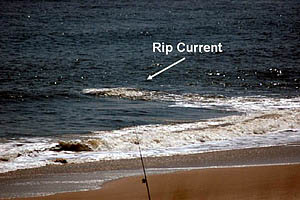More than 600 people have drowned in the Great Lakes since 2010. Jamie Racklyeft was almost one of them, and he’s determined to ensure that others survive as he did.
Rip currents are a potential source of danger for people in shallow water with breaking waves, whether in seas, oceans, or lakes rip currents and are the direct cause of 80% of beach lifeguard rescues. A rip current, also known as a rip tide or simply a rip, is a type of water current that can occur near beaches with breaking waves. A rip is a strong, localized, and narrow current of water that moves directly away from the shore, cutting through the breaking waves like a river. A rip current is strongest and fastest nearest the surface of the water.
Rip currents can be dangerous for swimmers. Swimmers caught in a rip current who do not understand what is happening or who lack the necessary water skills may panic or exhaust themselves by swimming directly against the flow of water.
A rip current is not the same as an undertow, though some people use the term interchangeably when referring to rip currents. Contrary to popular belief, neither a rip nor an undertow can drag a person underwater. A rip simply transports floating objects, including people, to just beyond the breaking wave zone, where the current dissipates and releases everything it is carrying.

Rip currents form when wind and breaking waves push surface water towards land, causing a slight rise in water level along the shore. This extra water will tend to return to the open water via the path of least resistance. When there is a local area that is slightly deeper, or a break in an offshore sand bar or reef, water can flow offshore more easily, causing a rip current to form through that gap.
Water pushed up near the beach flows as “feeder currents” along the shore towards the outgoing rip, and then the excess water flows out at a right angle to the beach in a tight current known as the rip’s “neck.” The “neck” is the point at which the flow is the fastest. When the water in the rip current reaches the edge of the breaking waves, the flow disperses sideways, loses power, and dissipates in the “head” of the rip.
Rip currents can form by the coasts of oceans, seas, and large lakes, whenever there are waves of sufficient energy. Rip currents often occur on a gradually shelving shore, where breaking waves approach the shore parallel to it, or where underwater topography encourages outflow at one specific area. The location of rip currents can be difficult to predict; some tend to recur always in the same places, but others can appear and disappear suddenly at various locations along the beach. The appearance and disappearance of rip currents is dependent on the bottom topography and the exact direction from which the surf and swells are coming.
Rip currents typically move at 0.5 m/s (1.6 ft/s), but they can reach speeds of up to 2.5 m/s (8.2 ft/s), which is faster than any human can swim. However, most rip currents are fairly narrow, and even the widest rip currents are not very wide; swimmers can usually exit the rip easily by swimming parallel to the beach at a right angle to the flow. Swimmers who are unaware of this fact may exhaust themselves trying to swim directly against the flow, which fades out completely at the head of the rip, outside the zone of breaking waves, so there is a definite limit to how far the swimmer will be taken out to sea by the current. A rip current is similar to a moving treadmill that a swimmer can easily escape by swimming at a right angle across the current, parallel to the shore in either direction. Because rip currents are usually not very wide, getting out of one takes only a few strokes. Once out of the rip current, returning to shore is simple because waves are breaking and floating objects (including swimmers) are pushed towards the shore by the waves.
People caught in a strong rip can also simply relax (floating or treading water) and allow the current to carry them until it dissipates completely once they are beyond the surf line. The individual can then signal for assistance or swim back through the surf, diagonally away from the rip and towards the shore.
Coastal swimmers must not only understand the dangers of rip currents, but also learn how to recognize and deal with them. And, whenever possible, people should only enter the water in areas where lifeguards are on duty.






